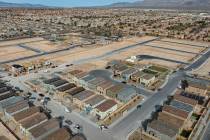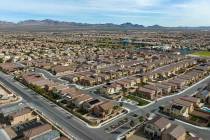Nevada’s boom ends in record number of empty homes


The promise of palm tree groves and low-priced real estate lured Alan and Katherine Ackerly across the Rocky Mountains from Denver to Nevada in 2004, where thousands of new houses beckoned brightly as any neon sign.
They came to buy their retirement home. But the real estate bust took its toll, with a flood of short sales and foreclosures in the market, and last month the Ackerly’s dream home was foreclosed on, too.
“I pretty much gave it back to them,” said Alan Ackerly, a 57-year-old electrician who stopped paying his mortgage because he owed more than the house was worth.
The Ackerly’s home is now among a swelling number of abandoned houses in Nevada. There were 167,564 empty houses in the state last year, according to newly released U.S. Census data, more than double the number in 2000. The number of vacant homes represents about one out of every seven houses across Nevada.
The figures are another striking example of how the housing crisis has pummeled Nevada, casting a new light on the severely weakened market after years of boom.
One result is an increase in code violations. In Clark County, home to Las Vegas, such complaints nearly doubled from 2008 to 2009 and the median price of resale homes dropped to $115,000 in January.
Neighbors call to complain of abandoned houses, stagnant pools, wild yards and unsecured doors, said Joe Boteilho, the county’s code enforcement chief. But the neighborhoods of newly constructed homes are not facing the same blatant signs of disrepair seen in other foreclosure-ravaged states such as Florida, Michigan and California.
About half of the 22,773 homes available for sale in Las Vegas are sitting empty, Realtor Tim Kelly Kiernan of ReMax Extreme said. Roughly 6,000 vacant homes have no pending or contingent offer on them, including 3,827 that are “distressed,” listed as either a foreclosure or short sale.
“That’s unique to our market because there are a lot of foreclosures in that number,” he said.
It has been a deep plunge for Nevada. Once a leader in job creation and construction, the state had the highest foreclosure rate in the country in January. Delinquent mortgages, meanwhile, are on the rise, with Las Vegas, Reno and Carson City all in the top eight cities per capita in a national real estate study published last month.
More than 16 percent of Nevadans relocated to new residences within the state in 2008 alone, the highest mobility rate in the nation, the Census data shows.
This in what was once the land of plenty. The expansion of glass towers and sprawling casinos on the Strip saw a 3.8 percent unemployment rate statewide in the beginning of 2000. Over the next decade, Nevada would grow by 35 percent, the fastest rate in the nation.
Men and women in hard hats carved homes into mountainsides, raised superstores from the dust and wedged plush golf courses into the desert. The state’s residential properties grew by more than 40 percent to 1.17 million homes during those years, affording Nevada the youngest housing stock in the country in 2009, according to the Census data. In Clark County, the school district saw an average of 10 new schools a year at its peak growth.
As houses and condominium towers rose from the ground, so did prices. The median home price went from $150,000 to $300,000 between 2000 and 2007, according to a University of Nevada, Las Vegas study.
“It was a new town,” said Dennis Smith, president of Home Builders Research, a Las Vegas real estate firm. “There was money everywhere. Everyone wanted to invest in Vegas.”
The state’s growing wealth and relaxed lending practices allowed workers with limited incomes to gain home ownership. In many cases, these were the same people who later faced foreclosure. Most Nevadans who lost their homes earned between $24,000 and $72,000, according to a homeowners survey published by the Nevada Association of Realtors in January. Roughly 60 percent said they lost their jobs first, then their homes.
Smith reported 4,761 new-home closings in 2010. At the height of the market in 2005, builders closed on 30,829 traditional single-family homes.
A general recovery seems far away. The state’s Foreclosure Mediation Program helped more than 4,200 homeowners since its creation in 2009. Nearly 2,000 of those owners were able to keep their properties.
More short sales and foreclosures are projected to further depreciate homes values across Nevada in 2011. Census data to be released starting in June was expected to highlight the state’s robust renters’ market.
“This year will be the worst,” said Rep. Shelley Berkley, D-Las Vegas, who co-chairs the Democratic Caucus Housing Stabilization Task Force in Washington. “The unemployment rate is not going down. The values of the homes keep going down and the ability to pay your mortgage is just not there.”


















